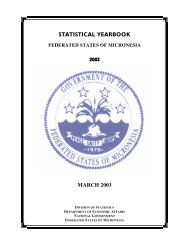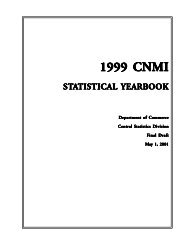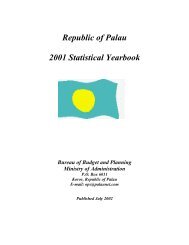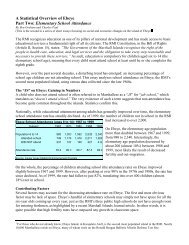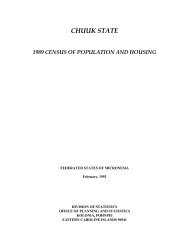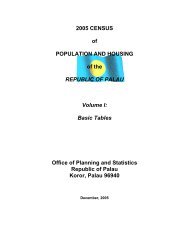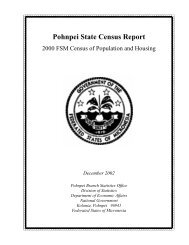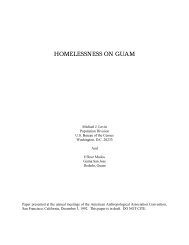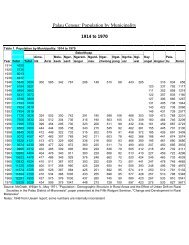Chapter 10. Industry and Occupation2000 FSM <strong>Census</strong> of <strong>Chuuk</strong> <strong>State</strong>Analysis of Industry and Occupation DataIndustryThe number of employed persons 15 years and over decreased between 1994 and 2000. Table 10.1 displays thebreakdown of selected industries in <strong>Chuuk</strong> <strong>State</strong> in 1994 and 2000. The proportion of persons in the large groupingscan be used to see trends in industry size. Data on industry and occupation refer to persons who were currently in theformal work force as well as persons who worked in the 5 years prior to the census.The distribution of employment changed during the 6-year time span between 1994 and 2000. For example, from 1994to 2000, the number of employed persons decreased by a little over 15 percent.The largest proportions of employed were in two industries – education and public administration. In 1994, the largestproportion of the economically active remained in public administration (26.7 percent) followed closely by education(25.5 percent). In 2000, the gap between these two widened, with public administration increasing to 35.5 percentwhile education actually fell 1 percent to 24.5 percent. By 2000, the percentage in public administration had continuedto increase, even though technical advice from the Asian Development Bank directed government officials to cut downon the size of government employment and to upgrade employability in the private sector.Of particular interest are two industries – agriculture, forestry, fishing and quarrying, and hotels, restaurants and bars.Taken more specifically, both industries are components of fishing, agriculture, and tourism. For the past 25 yearsgovernment reports have defined these three industries as the highest priorities in economic development. All thesame, both industries have shown that these priorities were not achievable in the 1990s and possibly for the 20 yearsfrom 1980 to 2000. By 2000, the first industry (agriculture, forestry, fishing and quarrying) carried nearly 2.0 percentof the economically active jobs, while tourism (hotels, restaurants, and bars) showed only 3.7 percent. In general,fishing, agriculture, and tourism are industries in the private sector, and the low proportions of 1.9 percent and 3.7percent attest to the failure of government efforts in encouraging more growth and development in the private sector.Table 10.1: Industry of Employment for Aged 15 Years and Over, <strong>Chuuk</strong> <strong>State</strong>: 1994 and 2000Number Percent change PercentIndustry 1994 2000 1994-2000 1994 2000Current formal work force 15+ years 5,373 4,546 (15.4) 100.0 100.0Agriculture, forestry, fishing and quarrying 432 88 (79.6) 8.0 1.9Construction 136 113 (16.9) 2.5 2.5Gas, electricity and water supply 28 85 203.6 0.5 1.9Transportation and communication 194 245 26.3 3.6 5.4Manufacturing 107 94 (12.1) 2.0 2.1Wholesale and retail trade 380 503 32.4 7.1 11.1Hotels, restaurants, and bars 187 168 (10.2) 3.5 3.7Financial intermediation and real estate 62 32 (48.4) 1.2 0.7Real Estate, Business & computer activities 84 62 (26.2) 1.6 1.4Health 375 273 (27.2) 7.0 6.0Education 1,369 1,116 (18.5) 25.5 24.5Public administration 1,435 1,614 12.5 26.7 35.5Other service activities 584 153 (73.8) 10.9 3.4Source: 1994 FSM <strong>Census</strong>, Table P29; 2000 FSM <strong>Census</strong>, Table 2-17Table 10.2 gives a more detailed breakdown of industries, by sex, in <strong>Chuuk</strong> in 1994 and 2000. The most obviousfinding is that males dominated employment in all industries except for hotel, restaurant, and bar sector. In 1994,among 5,373 economically active persons, 71.2 percent were males and 28.8 percent were females. In 2000, among4,546 economically active, 71.7 percent were males and 28.3 percent were females – very little change towardemployability of women in the labor force. Even higher percentages of males, by specific industry, were recorded in2000 – construction, 97.3 percent; electricity, gas and water supply, 92.9 percent; transportation and communication,91.4 percent; agriculture, forestry, fishing and quarrying, 90.9 percent; public administration, 82.8 percent; businessand computer activities, 80.6 percent; and other services, 77.1 percent. Females dominated only two particularindustries – hotels, restaurants and bars, 61.9 percent; and health, 52.7 percent. Under the generic heading ofmanufacturing, one specific industry (manufacturing of non-durables) had 59.5 percent females.The largest number of employees in the three primary industries – public administration, education, and wholesaleand retail trade – males dominated. In 1994, males comprised 85.2 percent of the economically active in publicadministration, 65.2 percent in education, and 53.4 percent in wholesale and retail trade. In the first two primary92 <strong>Chuuk</strong> Branch Statistics Office, Division of Statistics, FSM Department of Economic Affairs
2000 FSM <strong>Census</strong> of <strong>Chuuk</strong> <strong>State</strong>Chapter 10. Industry and Occupationindustries, the percentages of males declined in 2000 – 82.8 percent in public administration, and 62.5 percent ineducation. This decline might be a signal of a slow start in women’s equity. However, in wholesale and retail trade,males increased their dominance in 2000, with 59.2 percent (an increase from 55.4 percent in 1994).Table 10.2: Detailed Breakdown of Industry by Sex, <strong>Chuuk</strong> <strong>State</strong>: 1994 and 20001994 2000Number Percent Number PercentIndustry Total Males Females Total Males Females Total Males Females Total Males FemalesCurrent formal work force 15+ years 5,373 3,828 1,545 100.0 71.2 28.8 4,546 3,261 1,285 100.0 71.7 28.3Agriculture, forestry, fishing & quarrying 432 421 11 100.0 97.5 2.5 88 80 8 100.0 90.9 9.1Agriculture and livestock 28 28 - 100.0 100.0 - 38 34 4 100.0 89.5 10.5Forestry 1 1 - 100.0 100.0 - 1 1 - 100.0 100.0 -Fishing 358 351 7 100.0 98.0 2.0 39 36 3 100.0 92.3 7.7Mining 14 13 1 100.0 92.9 7.1 5 4 1 100.0 80.0 20.0Quarrying 2 2 - 100.0 100.0 - 5 5 - 100.0 100.0 -Manufacturing 107 68 39 100.0 63.6 36.4 94 57 37 100.0 60.6 39.4Manufacturing of non-durables 42 25 17 100.0 59.5 40.5 37 15 22 100.0 40.5 59.5Manufacturing of durables 65 43 22 100.0 66.2 33.8 57 42 15 100.0 73.7 26.3Electricity, gas and water supply 28 28 - 100.0 100.0 - 85 79 6 100.0 92.9 7.1Construction 136 127 9 100.0 93.4 6.6 113 110 3 100.0 97.3 2.7Wholesale and retail trade 380 203 177 100.0 53.4 46.6 503 298 205 100.0 59.2 40.8Wholesale trade 95 57 38 100.0 60.0 40.0 74 58 16 100.0 78.4 21.6Retail trade 246 118 128 100.0 48.0 52.0 380 199 181 100.0 52.4 47.6Trade relating to automotives 15 11 4 100.0 73.3 26.7 41 34 7 100.0 82.9 17.1Hotels, restaurants, and bars* 187 70 117 100.0 37.4 62.6 168 64 104 100.0 38.1 61.9Transportation and communication 194 167 27 100.0 86.1 13.9 245 224 21 100.0 91.4 8.6Land transport 37 34 3 100.0 91.9 8.1 22 20 2 100.0 90.9 9.1Water transport 62 58 4 100.0 93.5 6.5 117 114 3 100.0 97.4 2.6Air transport 45 35 10 100.0 77.8 22.2 19 16 3 100.0 84.2 15.8Other transport activities 20 15 5 100.0 75.0 25.0 58 48 10 100.0 82.8 17.2Post and telecommunications 26 21 5 100.0 80.8 19.2 28 25 3 100.0 89.3 10.7Financial intermediation 62 34 28 100.0 54.8 45.2 32 18 14 100.0 56.3 43.8Financial intermediation 50 29 21 100.0 58.0 42.0 26 16 10 100.0 61.5 38.5Insurance and pensions 2 2 - 100.0 100.0 - 4 2 2 100.0 50.0 50.0Other financial activities 10 3 7 100.0 30.0 70.0 2 - 2 100.0 - 100.0Business and computer activities 84 58 26 100.0 69.0 31.0 62 50 12 100.0 80.6 19.4Real estate 8 8 - 100.0 100.0 - 3 3 - 100.0 100.0 -Renting 13 8 5 100.0 61.5 38.5 6 4 2 100.0 66.7 33.3Computer activities 19 11 8 100.0 57.9 42.1 3 3 - 100.0 100.0 -Research and development 28 19 9 100.0 67.9 32.1 7 7 - 100.0 100.0 -Other business activities 16 12 4 100.0 75.0 25.0 43 33 10 100.0 76.7 23.3Public administration 1,435 1,223 212 100.0 85.2 14.8 1,614 1,337 277 100.0 82.8 17.2Education 1,369 893 476 100.0 65.2 34.8 1,116 697 419 100.0 62.5 37.5Primary education 395 250 145 100.0 63.3 36.7 711 434 277 100.0 61.0 39.0Secondary education 110 79 31 100.0 71.8 28.2 247 163 84 100.0 66.0 34.0Higher education 71 52 19 100.0 73.2 26.8 43 29 14 100.0 67.4 32.6Adult and other education 11 6 5 100.0 54.5 45.5 3 1 2 100.0 33.3 66.7Health and social work 363 189 174 100.0 52.1 47.9 273 129 144 100.0 47.3 52.7Other service activities 596 347 249 100.0 58.2 41.8 153 118 35 100.0 77.1 22.9Sewage and refuse disposal 12 10 2 100.0 83.3 16.7 8 6 2 100.0 75.0 25.0Activities of membership <strong>org</strong>anization 300 159 141 100.0 53.0 47.0 58 36 22 100.0 62.1 37.9Community service activities 16 15 1 100.0 93.8 6.3 76 69 7 100.0 90.8 9.2Private household activities 266 161 105 100.0 60.5 39.5 11 7 4 100.0 63.6 36.4Other establishments 2 2 - 100.0 100.0 - - - - - - -Source: 1994 & 2000 FSM <strong>Census</strong>, unpublished dataTable 10.3 shows different educational backgrounds of people employed in different industries. For definitions ofvocational and high school education, see Chapter 8 on Education. In 1994, about 62 percent of employed persons 15years and over had high school diplomas, compared to 57 percent in 2000. The 2000 <strong>Census</strong> figures show that in thefollowing four industries – financial intermediation, 96.9 percent; education, 82.9 percent; health, 73.6 percent; and realestate & business activities, 66.7 percent– more than two–thirds of the personnel were high school graduates. Thepercent of high school graduates in different industries was not uniformly higher for males or females. Gas, electricityand water supply and agriculture, forestry, fishing and quarry had at least 10 and 34 percentage points respectively,more females with high school diplomas than percentage males with high school diplomas.Also, in 1994, an average of 21 percent of all employed persons had some vocational training while the 2000 <strong>Census</strong>showed a slight increase to more than 22 percent. On average, vocational training varied by sector. For example, in1994, more than 48 percent of the individuals employed in the financial industries and more than 39 percent of theindividuals in health had vocational training compared with 11 percent of those in the hotels, restaurants and bars and12 percent of those in agriculture, forestry, fishing and quarrying. In 2000, the proportion of persons involved in theseindustries changed. For instance, agriculture, forestry, fishing and quarry and hotels, restaurants and bars increased by<strong>Chuuk</strong> Branch Statistics Office, Division of Statistics, FSM Department of Economic Affairs 93
- Page 5:
iii
- Page 12 and 13:
Preface2000 FSM Census of Chuukx
- Page 14 and 15:
Table of contents2000 FSM Census of
- Page 16 and 17:
LIST OF TEXT TABLESTABLEPageChapter
- Page 18 and 19:
List of Text Table2000 FSM Census o
- Page 20 and 21:
LIST OF FIGURESFIGUREPageFigure 1.1
- Page 22 and 23:
List of Basic-Tables2000 FSM Census
- Page 24 and 25:
MAP OF FSMxxiiChuuk Branch Statisti
- Page 27 and 28:
2000 FSM Census of Chuuk StateExecu
- Page 29 and 30:
CHAPTER 1INTRODUCTIONThe creation o
- Page 31 and 32:
2000 FSM Census of Chuuk StateChapt
- Page 33 and 34:
2000 FSM Census of Chuuk StateChapt
- Page 35 and 36:
2000 FSM Census of Chuuk StateChapt
- Page 37 and 38:
2000 FSM Census of Chuuk StateChapt
- Page 39 and 40:
2000 FSM Census of Chuuk StateChapt
- Page 41 and 42:
2000 FSM Census of Chuuk StateChapt
- Page 43 and 44:
2000 FSM Census of Chuuk State Chap
- Page 45:
2000 FSM Census of Chuuk StateChapt
- Page 48 and 49:
Chapter 2. Age and Sex Structure200
- Page 50 and 51:
Chapter 2. Age and Sex Structure200
- Page 52 and 53:
Chapter 2. Age and Sex Structure200
- Page 55 and 56:
CHAPTER 3HOUSEHOLDS, FAMILIES, AND
- Page 57 and 58:
2000 FSM Census of Chuuk StateChapt
- Page 59 and 60:
2000 FSM Census of Chuuk StateChapt
- Page 61:
2000 FSM Census of Chuuk StateChapt
- Page 64 and 65:
Chapter 4. Fertility2000 FSM Census
- Page 66 and 67:
Chapter 4. Fertility2000 FSM Census
- Page 68 and 69:
Chapter 4. Fertility2000 FSM Census
- Page 71 and 72: CHAPTER 5MORTALITYIntroductionAs re
- Page 73 and 74: 2000 FSM Census of Chuuk StateChapt
- Page 75: 2000 FSM Census of Chuuk StateChapt
- Page 78 and 79: Chapter 6. Migration2000 FSM Census
- Page 80 and 81: Chapter 6. Migration2000 FSM Census
- Page 82 and 83: Chapter 6. Migration2000 FSM Census
- Page 84 and 85: Chapter 6. Migration2000 FSM Census
- Page 86 and 87: Chapter 7. Religion, Ethnicity, and
- Page 88 and 89: Chapter 7. Religion, Ethnicity, and
- Page 90 and 91: Chapter 7. Religion, Ethnicity, and
- Page 92 and 93: Chapter 8. Education2000 FSM Census
- Page 94 and 95: Chapter 8. Education2000 FSM Census
- Page 96 and 97: Chapter 8. Education2000 FSM Census
- Page 98 and 99: Chapter 8. Education2000 FSM Census
- Page 100 and 101: Chapter 8. Education2000 FSM Census
- Page 103 and 104: CHAPTER 9ECONOMIC ACTIVITYIntroduct
- Page 105 and 106: 2000 FSM Census of Chuuk StateChapt
- Page 107 and 108: 2000 FSM Census of Chuuk StateChapt
- Page 109 and 110: 2000 FSM Census of Chuuk StateChapt
- Page 111 and 112: 2000 FSM Census of Chuuk StateChapt
- Page 113 and 114: 2000 FSM Census of Chuuk StateChapt
- Page 115 and 116: 2000 FSM Census of Chuuk StateChapt
- Page 117 and 118: CHAPTER 10INDUSTRY AND OCCUPATIONIn
- Page 119: 2000 FSM Census of Chuuk StateChapt
- Page 123 and 124: 2000 FSM Census of Chuuk StateChapt
- Page 125 and 126: 2000 FSM Census of Chuuk StateChapt
- Page 127 and 128: 2000 FSM Census of Chuuk StateChapt
- Page 129 and 130: CHAPTER 11INCOMEIntroductionThe 200
- Page 131 and 132: 2000 FSM Census of Chuuk StateChapt
- Page 133 and 134: 2000 FSM Census of Chuuk StateChapt
- Page 135 and 136: 2000 FSM Census of Chuuk StateChapt
- Page 137: 2000 FSM Census of Chuuk StateChapt
- Page 140 and 141: Chapter 12. Housing2000 FSM Census
- Page 142 and 143: Chapter 12. Housing2000 FSM Census
- Page 144 and 145: Chapter 12. Housing2000 FSM Census
- Page 146 and 147: Chapter 12. Housing2000 FSM Census
- Page 148 and 149: Chapter 12. Housing2000 FSM Census
- Page 150 and 151: Chapter 12. Housing2000 FSM Census
- Page 152 and 153: Chapter 12. Housing2000 FSM Census
- Page 154: Chapter 12. Housing2000 FSM Census
- Page 157 and 158: BIBLIOGRAPHYArriaga, E.E., (1983).
- Page 159: 2000 FSM Census of Chuuk StateBibli
- Page 162 and 163: Basic Tables2000 FSM Census of Chuu
- Page 164 and 165: Basic Tables2000 FSM Census of Chuu
- Page 166 and 167: Basic Tables2000 FSM Census of Chuu
- Page 168 and 169: Basic Tables2000 FSM Census of Chuu
- Page 170 and 171:
Basic Tables2000 FSM Census of Chuu
- Page 172 and 173:
Basic Tables2000 FSM Census of Chuu
- Page 174 and 175:
Basic Tables2000 FSM Census of Chuu
- Page 176 and 177:
Basic Tables2000 FSM Census of Chuu
- Page 178 and 179:
Basic Tables2000 FSM Census of Chuu
- Page 180 and 181:
Basic Tables2000 FSM Census of Chuu
- Page 182 and 183:
Basic Tables2000 FSM Census of Chuu
- Page 184 and 185:
Basic Tables2000 FSM Census of Chuu
- Page 186 and 187:
Basic Tables2000 FSM Census of Chuu
- Page 188 and 189:
Basic Tables2000 FSM Census of Chuu
- Page 190 and 191:
Basic Tables2000 FSM Census of Chuu
- Page 192 and 193:
Basic Tables2000 FSM Census of Chuu
- Page 194 and 195:
Basic Tables2000 FSM Census of Chuu
- Page 196 and 197:
Basic Tables2000 FSM Census of Chuu
- Page 198 and 199:
Basic Tables2000 FSM Census of Chuu
- Page 200 and 201:
Basic Tables2000 FSM Census of Chuu
- Page 202 and 203:
Basic Tables2000 FSM Census of Chuu
- Page 204 and 205:
Basic Tables2000 FSM Census of Chuu
- Page 206 and 207:
Basic Tables2000 FSM Census of Chuu
- Page 208 and 209:
Basic Tables2000 FSM Census of Chuu
- Page 210 and 211:
Basic Tables2000 FSM Census of Chuu
- Page 212 and 213:
Basic Tables2000 FSM Census of Chuu
- Page 214 and 215:
Basic Tables2000 FSM Census of Chuu
- Page 216 and 217:
Basic Tables2000 FSM Census of Chuu
- Page 218 and 219:
Basic Tables2000 FSM Census of Chuu
- Page 220 and 221:
Basic Tables2000 FSM Census of Chuu
- Page 222 and 223:
Basic Tables2000 FSM Census of Chuu
- Page 224 and 225:
Basic Tables2000 FSM Census of Chuu
- Page 226 and 227:
Basic Tables2000 FSM Census of Chuu
- Page 228 and 229:
Basic Tables2000 FSM Census of Chuu
- Page 230 and 231:
Basic Tables2000 FSM Census of Chuu
- Page 232 and 233:
Basic Tables2000 FSM Census of Chuu
- Page 234 and 235:
Basic Tables2000 FSM Census of Chuu
- Page 236 and 237:
Basic Tables2000 FSM Census of Chuu
- Page 238 and 239:
Basic Tables2000 FSM Census of Chuu
- Page 240 and 241:
Basic Tables2000 FSM Census of Chuu
- Page 242 and 243:
Basic Tables2000 FSM Census of Chuu
- Page 244 and 245:
Basic Tables2000 FSM Census of Chuu
- Page 246 and 247:
Basic Tables2000 FSM Census of Chuu
- Page 248 and 249:
Basic Tables2000 FSM Census of Chuu
- Page 250 and 251:
Basic Tables2000 FSM Census of Chuu
- Page 252 and 253:
Basic Tables2000 FSM Census of Chuu
- Page 254 and 255:
Basic Tables2000 FSM Census of Chuu
- Page 256 and 257:
Basic Tables2000 FSM Census of Chuu
- Page 258 and 259:
Basic Tables2000 FSM Census of Chuu
- Page 260 and 261:
Basic Tables2000 FSM Census of Chuu
- Page 262 and 263:
Basic Tables2000 FSM Census of Chuu
- Page 264 and 265:
Basic Tables2000 FSM Census of Chuu
- Page 266 and 267:
Basic Tables2000 FSM Census of Chuu
- Page 268 and 269:
Basic Tables2000 FSM Census of Chuu
- Page 270 and 271:
Basic Tables2000 FSM Census of Chuu
- Page 272 and 273:
Basic Tables2000 FSM Census of Chuu
- Page 274 and 275:
Basic Tables2000 FSM Census of Chuu
- Page 276 and 277:
Basic Tables2000 FSM Census of Chuu
- Page 278 and 279:
Basic Tables2000 FSM Census of Chuu
- Page 280 and 281:
Basic Tables2000 FSM Census of Chuu
- Page 282 and 283:
Basic Tables2000 FSM Census of Chuu
- Page 284 and 285:
Basic Tables2000 FSM Census of Chuu
- Page 286 and 287:
Basic Tables2000 FSM Census of Chuu
- Page 288 and 289:
Basic Tables2000 FSM Census of Chuu
- Page 290 and 291:
Basic Tables2000 FSM Census of Chuu
- Page 292 and 293:
Questionnaire2000 FSM Census of Chu
- Page 294 and 295:
Questionnaire2000 FSM Census of Chu
- Page 296 and 297:
Questionnaire2000 FSM Census of Chu



